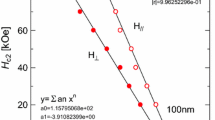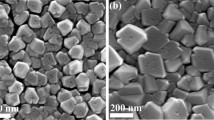Abstract
For the first time, a comparison to the predicted behavior for parallel critical field is carried out for the model of Kogan and the model of Hara and Nagai. In this study, thin niobium films in the moderately dirty regime were considered. Experimental values of the \(-C_{2}\) term are seen to be lower than those from the model of Hara and Nagai. A possible reason for this could be not including the non-spherical Fermi surface of niobium into the model. There is clearly disagreement with the model of Kogan as the films get cleaner and thinner, and two films which should be below his critical thickness still show positive values of \(-C_{2}\), in disagreement with his theory.






Similar content being viewed by others
References
H. Jeffrey Garnder et al., Nat. Phys. 7, 895 (2011)
D. Lenk et al., Phys. Rev. B 93, 184501 (2016)
V.G. Kogan, Phys. Rev. B 34, 3499 (1986)
V.G. Kogan, N. Kakagawa, Phys. Rev. B 35, 1700 (1987)
P. Scotto, W. Pesch, J. Low Temp. Phys. 84, 301 (1991)
J. Hara, K. Nagai, J. Phys. Soc. Jpn. 63, 2331 (1994)
M. Tinkham, Phys. Rev. 129, 2413 (1963)
T.P. Orlando, E.J. McNiff Jr., S. Foner, M.R. Beasley, Phys. Rev. B 19, 4545 (1979)
http://www.inrf.uci.edu/wordpress/wp-content/uploads/sop-wet-silicon-rca-1.pdf
L.J. van der Pauw, Phillips Res. Rep. 13, 1 (1958)
C. Kittel, Introduction to Solid State Physics, 8th edn. (Wiley, New York, 2005)
H.R. Kerchner, D.K. Christen, S.T. Sekula, Phys. Rev. B 24, 1200 (1981)
X. Zhao, L. Phillips, C.E. Reece, K. Seo, M. Krishnan, E. Vaderrama, J. Appl. Phys. 110, 033523 (2011)
J.H. Claassen, S.A. Wolf, S.B. Qadri, L.D. Jones, J. Cryst. Growth 81, 557 (1987)
P.C. Hohenberg, N.R. Werthamer, Phys. Rev. 153, 483 (1967)
Acknowledgements
The author would like to gratefully acknowledge the assistance of A. Hunziker and A. Davis in the film production and measurement, the support of Covenant College for this work, and Prof. C. B. Eom for the X-ray analysis. This work was performed in part at the Georgia Tech Institute for Electronics and Nanotechnology, a member of the National Nanotechnology Coordinated Infrastructure, which is supported by the National Science Foundation (Grant ECCS-1542174).
Author information
Authors and Affiliations
Corresponding author
Appendix
Appendix
Niobium samples used in this study | ||||||||||
|---|---|---|---|---|---|---|---|---|---|---|
Sample | Substrate | d (nm) | RRR | \(\rho _{\mathrm {10K}}\ (\mathrm {n}\Omega \mathrm {m}) \) | \(T_\mathrm{c0}\) (K) | \(D=d/\xi \) | \(\lambda _{\mathrm {tr}} \) | \(-C_{2} (\mathrm {Exp.}) \) | \(-C_{2} (\mathrm {HN}) \) | \(-C_{2} (\mathrm {Kogan}) \) |
A | (100) Si | 48 | 4.04 | 49 | 8.946 | 1.3 | 4.4 | 0.064 | 0.071 | 0.066 |
B | (100) Si | 23 | 2.68 | 89 | 7.777 | 0.54 | 10 | 0.0052(3) | 0.0065 | 0.0054 |
C | (100) Si | 48 | 2.68 | 89 | 8.262 | 1.2 | 9.5 | 0.027(1) | 0.036 | 0.035 |
D | (100) Si | 25 | 2.51 | \(1.0{\times }10^{2} \) | 8.426 | 0.63 | 10 | 0.0072(2) | 0.0087 | 0.0079 |
E | A plane Sap | 25 | 4.82 | 39 | 8.284 | 0.63 | 4.2 | 0.014 | 0.017 | 0.0072 |
F | C plane Sap | 52 | 3.77 | 54 | 8.649 | 1.4 | 5.5 | 0.056 | 0.074 | 0.066 |
G | (100) Si | 25 | 3.13 | 70 | 8.504 | 0.65 | 7.3 | 0.011 | 0.012 | 0.010 |
H | A plane Sap | 22 | 7.24 | 24 | 8.644 | 0.57 | 2.4 | 0.014 | 0.017 | \(-\)0.017 |
J | C plane Sap | 25 | 4.07 | 49 | 8.477 | 0.64 | 5.0 | 0.012 | 0.015 | 0.0094 |
K | C plane Sap | 16 | 2.53 | 98 | 7.615 | 0.37 | 11 | 0.0021 | 0.0027 | 0.0019 |
L | A plane Sap | 16 | 4.12 | 48 | 8.021 | 0.39 | 5.3 | 0.0043 | 0.0049 | \(-\)0.0072 |
M | C plane Sap | 26 | 2.63 | 92 | 8.264 | 0.64 | 9.8 | 0.0077 | 0.0092 | 0.0084 |
N | (100) Si | 24 | 3.01 | 75 | 8.600 | 0.63 | 7.6 | 0.0093(1) | 0.011 | 0.0090 |
P | C plane Sap | 20 | 2.68 | 89 | 8.050 | 0.49 | 9.7 | 0.0045 | 0.0053 | 0.0043 |
R | C plane Sap | 20 | 2.59 | 94 | 8.060 | 0.50 | 10 | 0.0051(3) | 0.0055 | 0.0044 |
S | C plane Sap | 39 | 3.27 | 66 | 8.520 | 1.0 | 6.8 | 0.024 | 0.032 | 0.029 |
Rights and permissions
About this article
Cite this article
Broussard, P.R. Parallel Critical Field in Thin Niobium Films: Comparison to Theory. J Low Temp Phys 189, 108–119 (2017). https://doi.org/10.1007/s10909-017-1792-0
Received:
Accepted:
Published:
Issue Date:
DOI: https://doi.org/10.1007/s10909-017-1792-0




